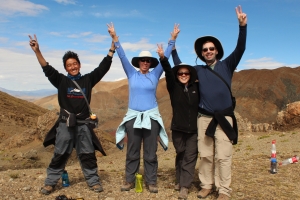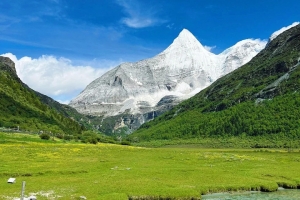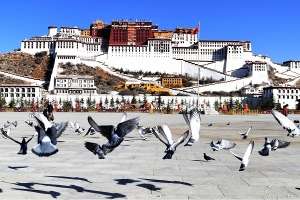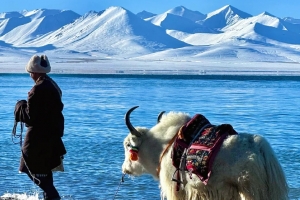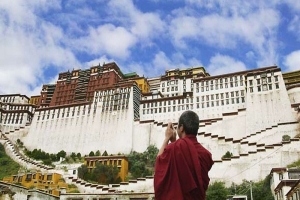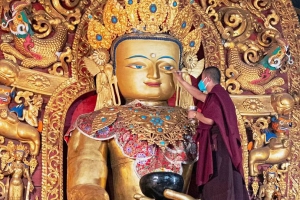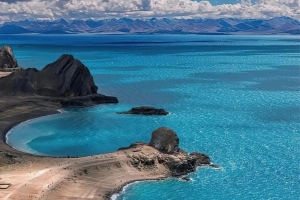Perched high in the rugged canyonlands of western Tibet, Tholing Monastery (Tibetan: ཐོ་གླིང་པོ) stands as a testament to the second diffusion of Buddhism on the plateau. Founded in 997 AD by King Yeshe‑Ö, the second ruler of the Guge Kingdom, this ancient gompa influenced Tibetan religious life for centuries. Located at an elevation of 12,400 feet (3,800 m) above sea level in Zanda County’s Tholing town—just 12 miles (19 km) east of Tsaparang and near the Ladakhi frontier—its lofty red walls seem to hover “in the sky forever,” as its Tibetan name suggests. Over time, Tholing evolved from the Nyingma school to Kagyu and finally Gelug, welcoming luminaries such as the Bengali master Atisha, whose residency here ignited a Buddhist renaissance. Though much of the monastery now lies in weathered ruins, three main halls and an expansive “pagoda forest” still reveal exquisite West Tibetan-style murals, ancient relics, and architectural ingenuity inspired by Samye Monastery. This article explores Tholing’s storied past, architectural layout, sacred treasures, and enduring cultural legacy, offering an in-depth guide for history enthusiasts and Tibet travelers alike.
Historical Significance of Tholing Monastery
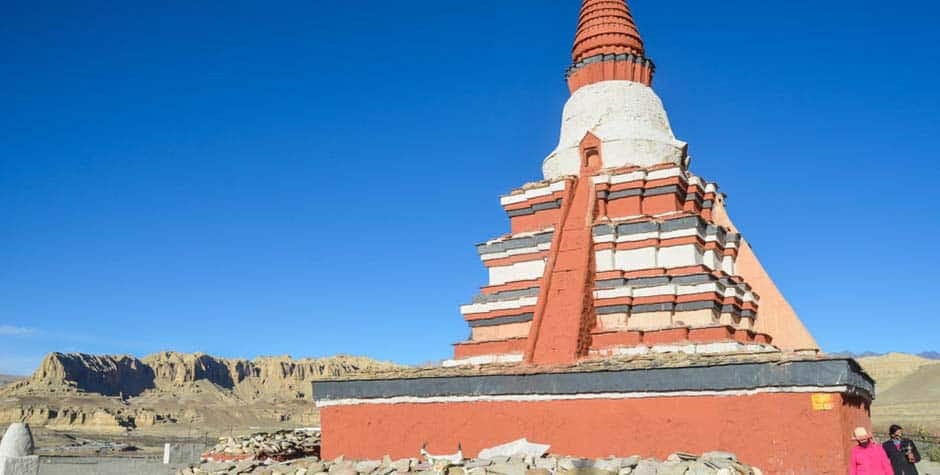
Founding during the Second Diffusion
Tholing Monastery was established in 997 AD at the dawn of Buddhism’s so‑called “second diffusion” in Tibet, a period marked by the revival of monastic institutions after political fragmentation in the 9th and 10th centuries. King Yeshe‑Ö, a devout supporter of Buddhism and patron of monastic scholarship, chose Tholing—then Guge’s capital—as the site for his spiritual centerpiece. Drawing inspiration from the first Tibetan monastery at Samye in southern Tibet, his architects laid out Tholing’s main complex with similar geometric precision. From the outset, the gompa served not only as a place of worship but as a university for religious study and translation, attracting scholars from across the Himalaya.
Atisha’s Arrival and the Buddhist Renaissance
In 1036 AD, the Indian master Atisha (982–1054 AD) arrived in western Tibet at the invitation of Yeshe‑Ö’s successors. Atisha took up residence at Tholing, lecturing on the Bodhisattva path and composing foundational texts that would shape Tibetan Buddhist thought for centuries. His presence elevated Tholing’s status to a pan‑Himalayan center of learning. Under royal patronage, the monastery expanded significantly, adding cloisters, chapels, and a vast library of Sanskrit and Tibetan scriptures. Numerous relics—elaborate ritual objects, scriptures, and personal items linked to Atisha—were enshrined here, many of which survive among the surrounding ruins.
Sectarian Transformations
Originally affiliated with the Nyingma (Old Translation) school, Tholing transitioned to the Kagyu lineage as its influence grew in western Tibet. By the 15th century, Ngawang Tsultrim (the Guge Tripa) realigned the monastery under the Gelug (Yellow Hat) order founded by Tsongkhapa. In 1618, Tholing hosted the fourth Panchen Lama, Lobsang Chökyi Gyaltsen, who further entrenched Gelugpa doctrines. In the early 1700s, the seventh Dalai Lama, Kelsang Gyatso, placed Tholing under the administrative wing of Sera Monastery’s Seji Dratsang college. From then on, the Tripa (abbot) and a rotating group of fifteen monks from Sera would govern Tholing for three‑year terms, maintaining a vibrant scholarly exchange between Lhasa and Ngari.
Architectural Layout of Tholing Monastery
Tholing Monastery’s design unfolds like a sacred belt conforming to the contours of its canyon perch, comprising three core zones: the central halls, monks’ quarters, and an extensive pagoda grove.
Central Halls
- Ghasa Hall (Gyesa Lhakhang): The earliest structure, this hall embodies a three‑dimensional mandala. A square central chamber symbolizes Mount Sumeru, the cosmic axis, while four smaller chapels at its sides represent the four continents, each corner featuring a stupa‑like guardian tower. Though time and seismic activity have stripped the hall of most sculptural elements and murals, its architectural conceptualization remains compelling.
- Assembly Hall (Lhakang Hall): The best‑preserved of the trio, this 588 m² sanctuary faces east toward sunrise. Thirty‑six sturdy pillars support a lofty roof under which sits a bronze statue of the third Buddha. Surrounding chambers include a courtyard, Dharma Protector chapel, and residential cells—once capable of housing over fifty monks.
- White Chapel (Karpo Lhakhang): Distinguished by its fifteen original statues and four walls of vibrant frescoes, the rectangular White Chapel features forty‑two intricately carved wooden pillars and capitals. The backlit niches hold shrouded images of Buddha and Tara, whose luminous silhouettes are best viewed with a flashlight, as natural light barely penetrates the deep‑set windows.
Monastic Quarters and Sutra Library
Adjacent to the main shrines, rows of monks’ cells (Larang) and the Atisha Sutra Hall once stored thousands of parchment manuscripts and leather scrolls. Today, only fragments of decorative beams and doorframes hint at the scholarly bustle that once animated these corridors.
Pagoda Forest (Stupa Grove)
To the north and northwest, two parallel walls enclose over 200 stupas of varying sizes, collectively known as the “Pagoda Forest.” Each wall features 108 small stupas, and at the center of one stands a grand “Descent from the God Realm” stupa with stairways on all sides. Local lore holds that King Yeshe‑Ö’s prayer beads are interred within each reliquary. At sunset, the ochre‑yellow stupas glow against the canyon walls, evoking the monastery’s former splendor.
The Three Sacred Relics of Tholing Monastery
Tholing’s reputation rests not only on its murals and halls but also on three unique relics said to embody the monastery’s spiritual heritage:
- Elk Antlers: Believed to have been brought from India by Atisha or harvested from the site of one of Buddha’s sermons, these oversized antlers (over two meters in length) are mounted above a sanctified altar.
- Ivory Five‑Buddha Crown: Symbolizing the Five Wisdom Tathagatas, this intricately carved ivory crown was worn by each Tripa during ritual ceremonies, linking successive abbots to the monastery’s founding lineage.
- Atisha’s Footprint Stone: A large black lava rock bearing a deep, inch‑deep palm imprint traditionally attributed to Atisha himself. Pilgrims touch this stone to receive blessings and affirm their connection to the master’s teachings.
Visiting Tholing Monastery Today
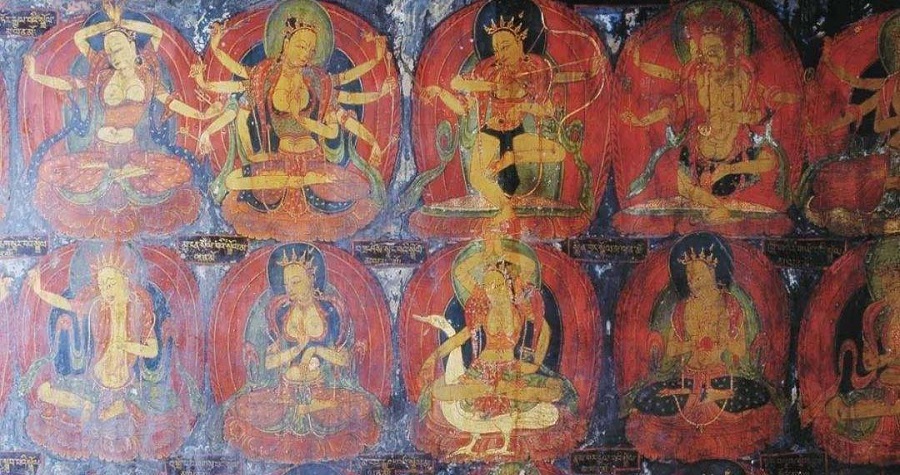
Most visitors reach Tholing via the winding highway from Darchen, the gateway town near Lake Manasarovar. From Darchen, a 163‑mile (262 km) drive through desert canyons leads to Tsaparang, and a further 12 miles (19 km) east brings travelers to Tholing. Due to its remote alpine location, travel is best planned between June and September, when roads are clear of snow.
What to See in Tholing Monastery
- Murals and Frescoes: While many have faded, pockets of remarkably preserved paintings adorn the inner sanctums of the three main halls. Early paintings reveal Nepali‑Indian influences in color palette and iconography.
- Pagoda Forest: Plan to arrive before sunset to witness the stupas bathed in golden light—a photographer’s delight.
- Local Homestays: Several guesthouses in Tholing town offer basic accommodations and home‑cooked meals, providing cultural immersion with local families of Tibetan heritage.
Practical Tips When Visiting Tholing Monastery
- At over 3,800 m, even fit travelers require a day’s rest in Darchen or Tsaparang to avoid altitude sickness.
- Monastic areas remain active pilgrimage sites. Visitors should dress modestly (shoulders and knees covered), remove hats in halls, and seek permission before photography.
- Essential for illuminating dim chapels, especially the White Chapel’s backlit statues.
Conclusion
Though time and the elements have reduced much of Tholing Monastery to ruins, its remaining structures, vivid murals, and storied relics continue to narrate the saga of Buddhism’s renaissance in western Tibet. As both an architectural marvel and a spiritual beacon—once home to luminaries like Atisha and overseen by generations of Guge’s royal patrons—Tholing offers a profound window into the religious and cultural currents that shaped the Tibetan plateau. For today’s traveler, it promises not only a journey into remote high‑altitude landscapes but a pilgrimage through layers of history, art, and devotion that still resonate in every ochre wall and silent stupa.

